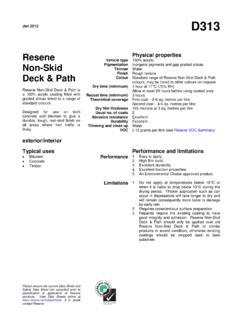Transcription of The Basic Recipe - Estheticals Skincare
1 The Basic Recipe This Basic Recipe is all you need to make perfect bath bombs that are so structurally sound you need a mallet to break them! 2 parts Sodium Bicarbonate 1 part citric acid A small amount of water That s all you really need to make bath bombs - we'll get to the added ingredients later - but this quick overview will give you an idea of how the Basic mix should look before you start adding in the extra bits. Overview Mix the dry ingredients. Spritz in a little water until it starts to clump together. Press mixture into your moulds , and demould your bombs. Let dry on a surface for 1-2 days. Getting it right Basic Bath Bomb Mix Mix 2 parts of sodium and 1 part citric acid in your bowl until you think they re combined. I usually start with 200g of sodium, 100g of citric acid.
2 It's a good idea to mix a little extra, set aside in a separate bowl, for when you add too much water/oil - it can really come in handy. Start adding the water by spritzing tiny amounts of water in at a time, mixing all the while, until the mix starts to clump together as you stir it. Don t add the water too fast - simply stir, spray, stir a lot more and don't spray until you are convinced it needs more water as the mixture seems to get wetter over time. A good tip is to squash any lumps of water or oil against the edge of the bowl with the back of your spoon. The Right Consistency This is the trickiest bit of making bath bombs, because it's so difficult to describe and there are a lot of things that effect getting the consistency right Different fragrances react differently to the mixture; The weather being to hot, too cold or too damp etc.
3 What is the right consistency? I can do my best to describe it, but you really have to experience it for yourself. I describe it as being like the most perfect snow you can imagine - it's still powdery when you move it about with your hand or spoon, but when you grab a hand full and squeeze it should stay packed together. A good test of this is to drop your lump of squeezed mix into your bowl. If it breaks apart completely it needs more liquid; If it stays fairly solid it's probably ready to mould. Here's some troubleshooting tips to give you an idea of whether you've got it right: Too Wet: Doughy or like play-doh or sticks to your fingers or on the mould If it feels wet or overly damp If you hear a loud hissing, crackling sound (faint hissing is inevitable) Too Dry: Hard, crumbly or pebbly slips through your fingers like sand When it clumps together for a few seconds, then crumbles apart (though this is almost there) If you add too much water, just soak it up by adding your prepared extra mix.
4 It has the proper ratio of 2 parts sodium / 1 part citric acid, so it won t screw up the balance. Adding citric acid or sodium on their own will result in less fizz power, though they will work in an emergency. Another tip for getting the right consistency is that it will be easy to mould and unmould them. You will have to be somewhat firm when you pack them into the moulds , but you won t have to squeeze the life out of them to get them to stay together. They will compress with little effort, so that the edges of your mould touch, or almost touch, and they will seem to drop right out of the mould (if it s round) when you unmould it. They shouldn t stick in the mould but clean the mould regularly during the batch making - just wipe it with a clean, dry cloth.
5 You can t leave your mixture sitting around before you mould your bombs. The water will evaporate, and your bombs will crack. If you stir the bomb mixture long enough, you ll see it transform almost in an instant. One moment, it will be clumping perfectly; the next, it ll crack like dry clay before your eyes. A good tip here is not to try making a huge batch, unless you have lots of helpers. The 'Knack' of Moulding This is one of those "it's easy when you know how" kind of things. So here's a few tips: I spoon the mixture into one half of the mould and 'cut' into it with the edge of the spoon before spooning another spoonful in. Fill the mould much more than half full- then set it aside and repeat with the other half mould. Carefully push the two halves together and squeeze firmly.
6 Remove the top half - place a sheet of cellophane in your palm and turn the unmoulded half onto your palm. You should then be able to easily remove the other half of the mould. Place the bomb gently on a clean dry surface. Colouring your bombs Liquid Colouring If you want to tint your bombs, you have to add the liquid colouring first, before you put in the water. The liquid food colouring is water-based and may be all you need to get the right consistency, depending on how many drops you use. There are colour limits to using liquid colouring, but it s the easiest kind of colouring to get. You can only add so much before your mixture gets too wet, and you can t make certain colours very well, especially purple or vibrant pink. Your liquid colour will foam a little and ball up when you try to blend it in.
7 To get it to distribute more evenly, try my tip of squashing the little balls against the side of the bowl with the back of your spoon. If you need more water, add it until you have the consistency described above. The water will also help distribute the colour. Use the extra mix if you accidentally make it too wet. Powdered Colorant The Powdered colours, from are premixed, especially for bath bomb making. This was done on the advice of our colour powder supplier, because premixing them makes them safer for children; gives greater control over adding the right amounts and makes colouring the bombs an all round easier job. They will still give you powerful colours - the manufacturer talks in "parts per million" so you can imagine the strength of them!
8 You only need a small amount of powdered colorant for eye-popping colour. Using More Than One Colour Making swirled or layered bath bombs is easy, but there is a little more labour and space required. I ve found that the best way to do it is: mix up your dry stuff, oils, fragrance, and other ingredients that aren t water, and separate the mixture into as many bowls as you want colours. Then, mix the colour and water in each bowl, separately. Some people put their colours into one big bowl and shake it a few times to get the swirl. I never do that - somehow, mine always blend together too much, and I get one yucky colour instead of a nice swirled effect. I keep them in separate bowls, and just scoop out the colours from each one as I go. It s important to get the right consistency for each colour; make sure they re about equal in moisture, otherwise your bath bombs might become unstable.
9 They might crack due to one colour being wetter than the others. Adding Herbs, Petals and Grains Here are some ideas for cool ingredients to add to your bath bombs to take them beyond the basics . Some of these I have actually used, some of them I haven t yet, but plan to. Oats Oatmeal or porridge oats bombs are my favourite! I have itchy skin, so I make these HUGE bombs that are half oat flour. Oatmeal contains mucilage, which is what makes it gooey and soothing to the skin. Don't add too much though, otherwise you ll end up with a bathtub full of half-cooked oats, yuk! Clay Some people use this as a functional additive, because white clay is said to make your bombs crack less and dry harder. I ve never had to use it for that purpose, but any kind of clay adds a great texture to the water - silky and smooth.
10 It can also be drying, so you might want to also add oils (if you didn t already.) Aloe Powder This stuff is cool, but kind of hard to find. Aloe powder is freeze-dried aloe, and if you get the 100X strength you can basically take a bath in aloe juice. It won t have the gel-like consistency as when it comes right out of the leaf. Perfect for sunburns in the summer, and goes great with a Green Tea & Aloe type fragrance. If you sell bath bombs, I bet these would sell really well as a summer special! Milk, Yogurt, or Goat s Milk Powder You can find powdered milk and goat s milk at health food stores, but you probably have to buy yogurt powder online. I don t know if this actually does anything for your skin - it s been a folk remedy throughout various cultures for softening and hydrating - but it definitely feels luxurious!






